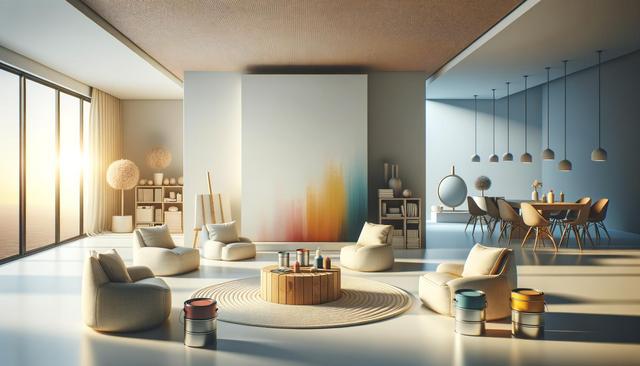Why Floor Paint is a Smart Renovation Choice
Floor paint is a practical and accessible solution for homeowners and renters looking to give their living spaces a fresh appearance without the need for extensive renovations. Whether you’re updating a tired garage, transforming a basement, or adding a stylish touch to a kitchen or hallway, floor paint can deliver impactful results. One of the main advantages is its affordability. Compared to replacing flooring materials like tile, hardwood, or carpet, painting floors requires a smaller investment and significantly less labor.
In addition to its cost-effectiveness, floor paint provides a versatile way to define a room’s aesthetic. From subtle neutral tones to bold, statement-making colors, the options are nearly endless. The type of finish—matte, satin, or glossy—also plays a key role in the final look and feel of the space. With the right preparation and tools, even DIY novices can achieve professional-looking results that enhance both the style and function of their space.
Choosing the Right Type of Floor Paint
Not all floor paints are created equal, and selecting the appropriate type is essential for durability and performance. The choice largely depends on the room’s purpose and the surface material. For example, epoxy-based paints are well-suited for concrete floors in garages or workshops due to their resistance to chemicals and heavy wear. On the other hand, latex-based floor paints are ideal for indoor areas like bedrooms or living rooms where foot traffic is moderate.
Here are a few types of floor paint to consider, based on your needs:
- Epoxy floor paint: Durable and chemical resistant, perfect for garages and basements.
- Latex floor paint: Easy to apply, dries quickly, and works well in living spaces.
- Polyurethane floor paint: Excellent for wood surfaces and high-gloss finishes.
- Anti-slip floor paint: Provides added safety in areas prone to moisture or spills.
Matching the paint type to the flooring material and expected usage ensures long-lasting results and minimizes the need for frequent touch-ups or repairs.
Preparing Your Floors for Painting
Proper preparation is crucial to achieving a smooth and lasting finish with floor paint. Skipping this step can lead to peeling, uneven coverage, or poor adhesion. Begin by thoroughly cleaning the floor to remove dust, debris, grease, or old coatings. For concrete surfaces, it may be necessary to etch the floor with a mild acid solution to open the pores and allow the paint to penetrate effectively.
Key preparation steps include:
- Cleaning the surface with a degreaser or appropriate cleaner
- Repairing cracks and holes with patching compounds
- Sanding wooden floors to remove old coatings
- Applying a primer if required by the paint product
Taking the time to prep the area properly will not only extend the life of your paint job but also improve the overall appearance of the finished surface. It’s a vital step that lays the groundwork for a successful transformation.
Design Ideas and Color Inspirations
Floor paint opens up limitless design possibilities, from minimalist tones to vibrant patterns. Choosing the right color scheme can completely shift the mood of a space. Lighter shades such as pale gray or soft beige can make a room feel more open and airy, while deeper hues like navy or charcoal add sophistication and depth. For a playful or artistic look, consider using stencils or painter’s tape to create geometric designs or faux tile effects.
Some creative ideas to explore include:
- Monochrome floors: Use one solid color for a clean, modern look.
- Two-tone designs: Add contrast with borders or alternating panels.
- Patterned finishes: Apply stencils for a tiled or Moroccan-inspired motif.
- High-gloss coatings: Reflect light and add a polished feel to contemporary spaces.
Don’t forget to coordinate your floor color with other elements in the room, such as wall paint, furniture, and fixtures. This helps create a cohesive and inviting atmosphere that reflects your personal style.
Maintaining Painted Floors for Long-Term Beauty
Once your floor paint has dried and cured, proper care ensures it retains its appearance and functionality for years to come. While high-quality floor paint is designed for durability, regular maintenance can prevent premature wear and maintain its appeal. Begin by avoiding harsh chemicals and abrasive tools when cleaning. Instead, use a soft mop or cloth with a gentle detergent.
To keep your painted floors looking their best:
- Place rugs or mats in high-traffic areas to minimize wear
- Use furniture pads to prevent scratching or chipping
- Wipe up spills promptly to avoid staining
- Reapply a topcoat or sealer periodically, as recommended
With minimal upkeep, painted floors can remain a vibrant and practical part of your home for many years. Regular inspection and touch-ups will help address minor issues before they become larger problems, preserving both the beauty and integrity of your painted surfaces.
Conclusion: A Simple Solution with Big Impact
Floor paint is an excellent way to breathe new life into your living space without the complexity or cost of full renovations. With the right preparation, paint type, and design approach, you can transform any room into a refreshed, stylish environment. Whether you’re updating a utilitarian garage or adding flair to a cozy reading nook, floor paint offers a practical and creative outlet. By taking the time to choose suitable colors and finishes and following through with proper maintenance, you can enjoy the benefits of your revamped floors for years to come.




Leave a Reply